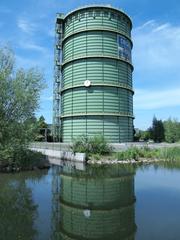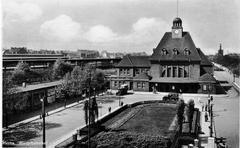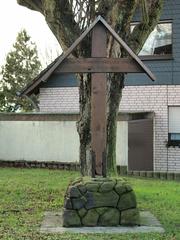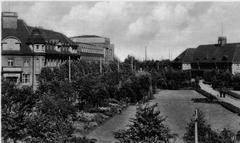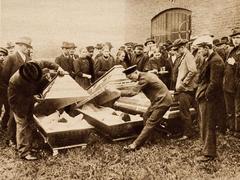
Zeche Constantin Herne: Visiting Hours, Tickets, and Historical Site Guide
Date: 04/07/2025
Introduction: A Living Monument of Ruhrgebiet’s Industrial Heritage
Zeche Constantin in Herne, Germany, is not simply a former coal mine—it is a vibrant testament to the Ruhrgebiet’s industrial era and a cornerstone of local identity. Established in the 19th century and stretching across Herne and Bochum, the site offers visitors a unique opportunity to experience the history, architecture, and community spirit that defined the region’s coal mining tradition. Today, the preserved miners’ settlement, cultural events, and notable landmarks make Zeche Constantin a must-visit destination for history enthusiasts, families, and anyone interested in Germany’s transformative industrial past (herne-damals-heute.de, sc-constantin.de, WAZ).
Table of Contents
- Historical Overview: Foundation and Development
- Technological Progress and Peak Years
- Life and Community in the Miners’ Settlement
- Challenges, Tragedies, and Transformation
- Decline and Closure
- Visitor Information: Hours, Tickets, and Accessibility
- Guided Tours, Events, and What to See
- FAQs
- Architectural Highlights and Siedlung
- Nearby Attractions and Practical Tips
- Legacy and Cultural Significance
- Summary and Further Reading
Historical Overview: Foundation and Development
The origins of Zeche Constantin date back to the mid-1800s. Between 1844 and 1846, the mining fields Joachim, Bochum, and Apollonia were consolidated, and in 1847, the “Zeche Vereinigte Constantin der Große” was formed, named after Emperor Flavius Valerius Constantinus. The actual coal extraction began in 1857, after overcoming initial technical challenges. The mine quickly grew, with additional shafts developed in Bochum and Herne, shaping the economic and social landscape of the region (herne-damals-heute.de, Wikipedia).
Technological Progress and Peak Years
By the late 19th and early 20th centuries, Zeche Constantin had become a major industrial hub. The construction of shafts 4 and 5 in Herne-Sodingen (1893–1900) marked a period of rapid expansion. At its peak in 1955, the mine employed over 5,000 workers and produced more than 1.4 million tonnes of coal annually. Constantin was renowned for technical innovation, including the development of an extensive railway system for coal transport and the construction of advanced ventilation shafts (komoot.com, wiki.hv-her-wan.de).
Life and Community in the Miners’ Settlement
The Zechensiedlung Constantin, or miners’ settlement, is one of the most striking features of the site. Built over several decades, the neighborhood fostered a strong sense of community among miners and their families. Architecturally, the settlement reflects eras of social housing—from spacious officials’ homes to carefully designed workers’ houses, many adorned with Jugendstil details. Social life revolved around local clubs, traditions, and the SC Constantin football club, which continues to serve as a community hub (komoot.com, sc-constantin.de).
Challenges, Tragedies, and Transformation
Zeche Constantin’s history includes moments of adversity, such as the tragic 1934 Schlagwetter explosion that claimed nine lives. The mine underwent several mergers and expansions, including the integration of Zeche Mont Cenis in 1939. The shifting economic landscape of the 1960s, however, signaled the decline of coal mining in the region (komoot.com).
Decline and Closure
The gradual downturn led to the closure of key production facilities in 1966, with final operations ceasing in 1967. The end of mining marked the beginning of a new chapter for the area, characterized by conservation, urban renewal, and a renewed focus on cultural heritage (komoot.com).
Visitor Information: Hours, Tickets, and Accessibility
Visiting Hours and Admission
Zeche Constantin’s settlement is a living neighborhood, not a traditional museum. There are no official visiting hours or entrance fees; the streets and exteriors are open to the public at all times. Please be respectful of current residents.
- Guided Tours: Occasional tours are provided by local organizations or the Herne monument authority. These must be booked in advance. Check Herne city website for updates.
- Events: Watch for special cultural events, heritage days, or SC Constantin football matches—these offer unique ways to experience local traditions.
Accessibility
- Public Transport: Easily reachable via Herne or Bochum train stations, with local buses and the U35 Stadtbahn line stopping at “Zeche Constantin”.
- Parking: Limited street parking is available. Cycling or use of public transport is recommended.
- Mobility: Streets are mostly level and paved, suitable for wheelchairs and strollers, though some sidewalks may be narrow or uneven.
Guided Tours, Events, and What to See
Self-Guided Exploration
- Pieperstraße and Courrièresstraße: Admire protected miners’ houses with distinctive gables, bay windows, and Jugendstil facades (WAZ).
- Protegohauben: The former shaft heads are marked by distinctive protective caps at the edge of the former spoil heap.
- Community Life: On market days, local vendors sell fresh produce, offering insight into neighborhood traditions.
Guided Tours
- Local history societies offer architecture and mining tours, especially during events like the Tag des offenen Denkmals (Open Monument Day). Participation is usually free or low-cost (herne.de).
Events
- Football Matches: SC Constantin games are social highlights and open to visitors.
- Festivals and Commemorations: Attend cultural festivals and memorial events honoring the area’s mining heritage.
FAQs
Is Zeche Constantin a museum?
No, it is a residential neighborhood with historic buildings and open public spaces.
Are there entrance fees or tickets?
No, the area is freely accessible. Some guided tours or events may require advance booking or a small fee.
Are guided tours available?
Yes, but only on specific dates or by prior arrangement.
Is it accessible for people with disabilities?
Most streets are level and paved, but some areas may have narrow sidewalks.
Where can I find food/restrooms?
There are no facilities within the settlement; visit Herne city center for dining and amenities.
Architectural Highlights and Siedlung
- Miners’ Houses: Early 20th-century homes, many still inhabited by descendants of original miners.
- Jugendstil Details: Notable facades on Pieperstraße and Courrièresstraße.
- Community Infrastructure: Former “Konsumanstalt” and Haus Voss, a longstanding local gathering spot.
- Constantiner Siedlung: 1950s housing expansion, representing post-war architectural trends.
Nearby Attractions and Practical Tips
- Schloss Strünkede: Renaissance castle with museums.
- LWL-Museum für Archäologie: Interactive archaeological displays.
- Gysenbergpark: Leisure and green space, including the Mühlendenkmal.
- Zeche Zollern/Deutsches Bergbau-Museum Bochum: Essential stops for industrial heritage enthusiasts (nrw-tourist.de, The Crazy Tourist).
Tips:
- Bring rain gear; the Ruhrgebiet is known for sudden showers.
- Use public transport or bike to minimize environmental impact.
- Respect residents’ privacy—avoid photographing private spaces without permission.
Legacy and Cultural Significance
Zeche Constantin embodies the Ruhrgebiet’s transformation from a coal-mining center to a modern, livable urban region. The preserved settlement, cultural activities, and ongoing community life keep mining history alive, blending tradition with contemporary urban renewal. Events, guided tours, and the continued vitality of SC Constantin football club reinforce a sense of shared heritage and identity (halloherne.de).
Summary and Further Reading
Zeche Constantin offers an authentic, accessible window into the Ruhrgebiet’s industrial and social history. Whether exploring the historic streets, joining a guided tour, or attending a local event, visitors gain unique insights into a living community shaped by generations of miners and their families. For the latest information on events, tours, and visitor tips, consult official city websites and local cultural organizations.
For digital guides and self-led tours, download the Audiala app and follow related articles on industrial heritage in the Ruhr region.
Sources:
- herne-damals-heute.de
- sc-constantin.de
- WAZ
- halloherne.de
- herne.de
- komoot.com
- wiki.hv-her-wan.de
- Wikipedia
- nrw-tourist.de
- The Crazy Tourist
- Traveloka

